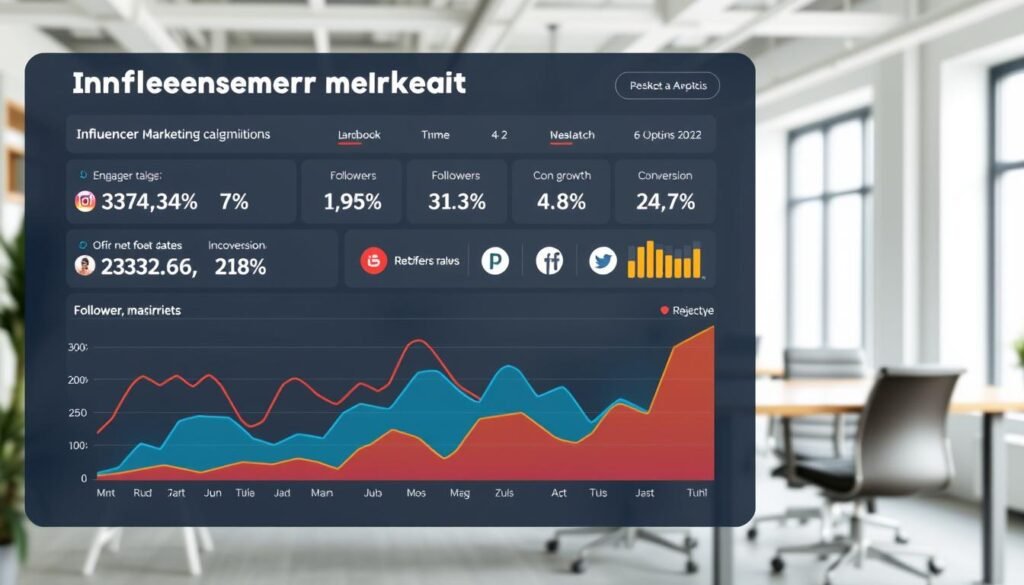Address
304 North Cardinal
St. Dorchester Center, MA 02124
Work Hours
Monday to Friday: 7AM - 7PM
Weekend: 10AM - 5PM
Address
304 North Cardinal
St. Dorchester Center, MA 02124
Work Hours
Monday to Friday: 7AM - 7PM
Weekend: 10AM - 5PM

Are you finding it hard to make your brand stand out? Are you using influencer marketing to its full potential? Today, teaming up with the right influencers can really boost your brand.
You must find the right influencers, make content that grabs attention, and check how well your campaigns do. This way, you can unlock the full power of influencer marketing. It can help your brand achieve great things.
To make the most of influencer marketing, you need to know what it’s all about. It’s about working with people who have lots of followers on social media or blogs. They help promote your brand, which can really help you reach more people and get your brand noticed.
Influencer marketing is a way to use social media to get your brand noticed. It involves people who have lots of followers and are seen as experts in their field. They can help you reach their audience, giving your brand credibility and possibly boosting sales. It’s important to pick influencers whose followers match your brand’s target audience.
Influencer marketing offers many benefits. It can really help increase brand awareness by showing your brand to more people who might be interested. It also makes your brand seem more credible because influencers are like trusted friends recommending you. Plus, it can help sell more and get more people to visit your website.
Influencers can be different based on how many followers they have and what they’re about. Here are the main types:
| Type of Influencer | Follower Count | Engagement Level |
|---|---|---|
| Nano-Influencers | 1,000 – 10,000 | High |
| Micro-Influencers | 10,000 – 100,000 | Moderate to High |
| Macro-Influencers | 100,000 – 1,000,000 | Moderate |
| Mega-Influencers | 1,000,000+ | Low to Moderate |
Knowing about these types is key to picking the right influencers for your campaign. It helps make sure your message gets to the right people.
Your influencer marketing strategy’s success depends on knowing your target audience well. Knowing who your ideal customer is helps you tailor your marketing to reach them effectively.
To find your target audience, look at demographics and psychographics. Demographics cover age, gender, location, and income. Psychographics explore their interests, values, and lifestyle.
For example, if you’re marketing a fitness product, your audience might be 25-45-year-olds who care about health. Knowing these details helps you create a marketing strategy that really works.
Doing deep market research is key to knowing your audience. You can use surveys, social media listening, and customer data analysis.
Surveys and questionnaires give direct insights into what your audience likes and does. Social media listening helps you see what your audience talks about and what they’re into.
By mixing these research methods, you can build a detailed picture of your audience. This lets you make a better influencer marketing plan.

Marketing expert Philip Kotler says, « Knowing your customer is the key to successful marketing. » This is especially true for influencer marketing. It helps you pick influencers who match your audience’s interests and values.
« The aim of marketing is to know and understand the customer so well the product or service fits him and sells itself. »
Finding the perfect influencer for your brand is key. The right one can spread your message, boost awareness, and sell more. But, with so many influencers online, it’s hard to find the right one.
First, you must decide between micro and macro influencers. Micro-influencers have 1,000 to 100,000 followers. They often have high engagement rates because they focus on a specific niche. Macro-influencers, with many followers, can reach more people and seem more authoritative.
Choose based on your campaign goals. Micro-influencers are great for targeted engagement. Macro-influencers are better for wider awareness.
Checking an influencer’s credibility is essential. Look at their content quality, engagement rates, and audience. An influencer with a small but engaged audience is more valuable than one with many followers but low engagement.
As Forbes says, « Influencer marketing is not just about reaching many people, but the right people. »
« The key to a successful influencer partnership is not just the size of their following, but how engaged their audience is. »
It’s important to match your brand values with the influencer’s. When their values match yours, the campaign feels more genuine and connects better with their followers.
By choosing an influencer who shares your brand’s values, you can make a campaign that truly stands out.
Clear goals and objectives are key to a good influencer marketing strategy. Knowing what you want to achieve helps you focus your campaign. This makes your efforts more successful.
To see if your influencer marketing is working, you need to pick the right metrics. These could be things like how many people engage with your content, visit your website, or make a purchase. Choosing the right key performance indicators (KPIs) is very important.
For example, if you want more people to know about your brand, you might look at:
| Metric | Description | Example |
|---|---|---|
| Reach | The number of people who viewed your content | 10,000 |
| Engagement Rate | The percentage of people who engaged with your content | 2% |
| Mentions | The number of times your brand is mentioned | 500 |
Different campaigns have different goals. For instance, a sponsored post might aim to sell more, while a product review aims to build trust. Matching your campaign with your goals is key to getting the most value.
As influencer marketing expert,
« The key to a successful influencer campaign is not just about reaching a large audience, but about reaching the right audience with the right message. »
This shows why it’s crucial to match your goals with your campaign type.
By setting clear goals, choosing the right metrics, and matching your campaign type, you can make your influencer marketing better.
To make your influencer marketing work better, you need a strong campaign strategy. This means knowing who you’re talking to, what you want to achieve, and making content that speaks to them.

The key to a great influencer marketing campaign is engaging content. This can be things like sponsored posts, product reviews, or fun contests. To make content that grabs attention, you must know what your audience likes and how they like to interact.
For example, young adults might love video content or interactive posts. But older folks might prefer detailed reviews or tutorials.
Storytelling is a big deal in influencer marketing. It helps brands connect with people on a deeper level. By sharing real stories, influencers can make your brand more relatable and memorable. Good storytelling is authentic and grabs your attention, often through emotion or adventure.
For example, a fitness brand might team up with an influencer to share their fitness journey. They could talk about the challenges they faced and how your products helped them reach their goals.
Using multi-channel campaigns can help you reach more people and get more engagement. This means promoting your campaign on different social media platforms like Instagram, YouTube, TikTok, and Twitter. Each platform has its own special features and audience, so you need to make your content fit each one.
By spreading your campaign across many channels, you can get your brand seen by more people. For example, Instagram is great for photos, YouTube for detailed reviews, and TikTok for short, fun videos.
Building trust with influencers is key to successful influencer marketing. To do this, you must use strategies that build strong, professional bonds.
Personalizing your messages is crucial when contacting influencers. Generic emails get ignored. Take the time to research and tailor your approach to show you value their work.
Here are some tips for initial outreach:
As Neil Patel, a renowned digital marketing expert, once said, « The key to successful influencer marketing is to build relationships, not just transactions. »
« Influencer marketing is not just about paying someone to promote your product; it’s about building a relationship with someone who has an audience you want to reach. »
Networking with influencers is more than just the first contact. It’s about ongoing engagement and building a relationship that benefits both parties. Here are some networking tips:
| Networking Tip | Description |
|---|---|
| Engage with their content | Like, comment, and share their posts to show your support. |
| Attend industry events | Meet influencers in person at conferences, workshops, and other industry events. |
| Collaborate on multiple campaigns | Work with influencers on multiple projects to build a long-term relationship. |
By using these strategies, you can create lasting relationships with influencers. These relationships will benefit your brand in the long run.
To get the most out of influencer marketing, managing collaborations well is key. This means using several important strategies. These strategies help your campaigns run smoothly and meet their goals.
Good communication is the base of a successful influencer partnership. Regular updates and check-ins are crucial. They make sure both sides are on the same page about what needs to be done.
Tools like collaboration tools (Trello or Asana) can make communication easier. They keep all important info in one spot. Being quick to respond to influencers’ questions also helps build a good working relationship.
It’s important to clearly set out what’s expected and what needs to be done. This includes what kind of content, when it’s due, and any specific rules about messaging or branding.
A detailed contract or agreement can protect both your brand and the influencer. Make sure the goals are specific, measurable, achievable, relevant, and time-bound (SMART). This makes your campaign more effective.
| Deliverable | Description | Timeline |
|---|---|---|
| Instagram Post | High-quality image with brand messaging | Within 2 weeks |
| YouTube Video | Product review or unboxing | Within 4 weeks |
| Twitter Thread | Series of tweets highlighting brand benefits | Within 1 week |
It’s crucial to keep an eye on how your influencer collaborations are doing. Look at things like engagement rates, reach, and conversions.

Analytics tools give you insights into how well your campaigns are doing. This helps you make better decisions for future collaborations. Talking regularly with your influencers about how things are going can also help spot areas for improvement.
To see how well your influencer marketing works, you need to track key metrics. This helps you know what’s working and what needs a tweak.
KPIs are vital for checking if your influencer marketing is a hit. You should keep an eye on:
Watching these KPIs gives you insights into how your campaigns are doing. This helps you make smarter choices for the next ones.
Using social media analytics tools is key for tracking your campaign’s success. They give you deep insights into your KPIs and help you get to know your audience. Some top tools are:

With these tools, you can fine-tune your influencer marketing plan. This boosts your campaign’s success.
When you start with influencer marketing, knowing the legal and ethical rules is key. This field, like any marketing, has rules to keep things fair and open. These rules help build trust between everyone involved.
Transparency is key in influencer marketing. The UK’s Advertising Standards Authority (ASA) and the Competition and Markets Authority (CMA) have rules. They say that sponsored content must be clearly marked.
To follow these rules, influencers must clearly say when a post is sponsored. They can use words like « ad, » « sponsored, » or « affiliate. » This should be easy to see, not hidden in hashtags or deep in the post.
| Disclosure Method | Description | Example |
|---|---|---|
| Hashtag Disclosure | Using specific hashtags to indicate sponsored content. | #ad, #sponsored |
| Clear Statement | A straightforward statement within the content. | « This post is sponsored by [Brand Name] » |
| Platform-Specific Features | Utilizing features provided by social media platforms. | Instagram’s « Branded Content » tag |
It’s not just about following the law; ethical partnerships are also crucial. You should pick influencers who share your brand’s values. Make sure their content is real and respectful.
Authenticity is crucial in influencer marketing. People can spot fake partnerships or content. So, choose influencers who genuinely believe in your brand and can naturally share your products or services.
By focusing on both legal rules and ethics, you can create a strong influencer marketing plan. This plan will not only follow the law but also build trust and credibility with your audience.
Optimizing your influencer marketing campaigns is a never-ending task. It involves looking at feedback, checking how well things are working, and making changes. This cycle keeps your campaigns strong and on track with your goals.
It’s key to listen to what the influencer and your audience have to say. You can get this feedback through social media, surveys, and direct talks with the influencer.
Key areas to focus on when analyzing feedback include:
After looking at the feedback, you can start making things better. This might mean changing your content plan, picking different influencers, or trying new marketing ways.
Effective continuous improvement strategies include:
| Improvement Strategy | Description | Potential Impact |
|---|---|---|
| Content Strategy Adjustment | Modifying the type or tone of content to better resonate with the target audience | Increased engagement and campaign effectiveness |
| Influencer Selection | Choosing influencers who better align with the campaign’s target audience and objectives | Improved campaign relevance and credibility |
| Multi-Channel Approach | Expanding the campaign to include additional marketing channels, such as email or paid social media | Increased reach and campaign visibility |
Looking at real-life influencer marketing campaigns can teach us a lot. It shows us what makes influencer partnership success happen. By studying both hits and misses, we can learn the best strategies for our brands.
For example, Daniel Wellington and Gymshark have made big impacts through influencer marketing. They’ve used it to boost engagement and sales. Their success stories are worth noting.
Learning from these campaigns, we find important factors for influencer partnership success. These include matching brand values with influencer audiences and making engaging content. We can use these insights to improve our own influencer marketing efforts.
To find the right influencers, look at their relevance, reach, and credibility. Choose influencers who genuinely care about your brand or niche. Their audience should match your target audience. Use platforms, social media tools, and manual research to find them.
To check if your campaigns are working, track engagement, reach, conversions, and ROI. Use social media analytics to see how your campaigns are doing. This helps you make better decisions for future strategies.
Micro-influencers get more engagement and are cheaper, great for niche campaigns. Macro-influencers reach more people and are better for big brand awareness. Think about your goals and audience to choose the right influencer size.
To follow the rules, clearly mark sponsored content. Stick to guidelines from bodies like the UK’s ASA. Make sure your influencers know the importance of being open and follow these rules.
A good influencer partnership needs clear communication and clear goals. Talk openly, give a clear brief, and check on progress. This ensures a successful partnership.
Analyse your campaign data to find ways to improve. Change your targeting, content, and influencer choices based on what you learn. Keep refining your strategy to get the best ROI.
Storytelling is key in influencer marketing. It helps brands connect deeply with their audience. Encourage influencers to share real, engaging stories that show off your brand’s values.
To build lasting relationships, start with good outreach, like personal messages and offering value. Engage with their content, go to industry events, and keep in touch. This builds a strong partnership.